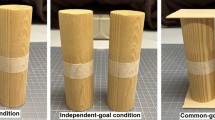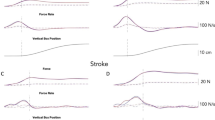Abstract
Previously we found that children with hemiplegic cerebral palsy (CP) have impaired bimanual coordination compared to typically developing children during a functional drawer-opening task. However, performance of the task under time constraints (fast-as-possible) facilitated better bimanual coordination for these children. Accuracy is another important task constraint that could influence the coordination of the two hands during such tasks. The effect of accuracy constraints on bimanual coordination in children with hemiplegic CP is not well understood. In the present study, children were asked to reach forward and open a drawer with one hand and then activate a light switch inside the drawer with the contralateral hand. Task accuracy constraints (different handles and switch sizes) were manipulated in order to determine their effect on upper extremity coordination. Eleven children with hemiplegic CP (age 8–16 years) and eleven age-matched typically developing children participated in this study. The results show that higher accuracy constraints prolong the total movement completion time for both groups of children. However, children with hemiplegic CP demonstrated less sequential movement with a higher accuracy constraint (a smaller knob handle) than a lower accuracy constraint (a larger loop handle). Nevertheless, presentation of both higher accuracy constraints (handle and switch) at the same time was detrimental to their performance. These influences of task constraints were similar regardless of which hand was used to open the drawer. The results suggest that performance may not be linearly related to the constraints, and in some cases “more is not better”.



Similar content being viewed by others
References
Aizawa H, Mushiake H, Inase M, Tanji J (1990) An output zone of the monkey primary motor cortex specialized for bilateral hand movement. Exp Brain Res 82:219–221
Aramaki Y, Honda M, Sadato N (2006) Suppression of the non-dominant motor cortex during bimanual symmetric finger movement: a functional magnetic resonance image study. Neuroscience 141:2147–2153
Brown JV, Schumacher U, Rohlmann A, Ettlinger G, Schmidt RC, Skreczek W (1989) Aimed movements to visual targets in hemiplegic and normal children: is the “good” hand of children with infantile hemiplegia also normal? Neuropsychologia 27:283–302
Charles J, Gordon AM (2006) Development of hand-arm bimanual intensive training (HABIT) for improving bimanual coordination in children with hemiplegic cerebral palsy. Dev Med Child Neurol 48:931–936
Cramer SC, Finklestein SP, Schaechter JD, Bussh G, Rosen BR (1999) Activation of distinct motor cortex regions during ipsilateral and contralateral finger movements. J Neurophysiol 81:383–387
Eliasson AC, Gordon AM, Forssberg H (1991) Basic co-ordination of manipulative force of children with cerebral palsy. Dev Med Child Neurol 33:661–670
Eliasson AC, Gordon AM, Forssberg H (1992) Impaired anticipatory control of isometric forces during grasping by children with cerebral palsy. Dev Med Child Neurol 34:216–225
Eliasson AC, Gordon AM, Forssberg H (1995) Tactile control of isometric fingertip forces during grasping in children with cerebral palsy. Dev Med Child Neurol 37:72–84
Forssberg H, Eliasson AC, Redon-Zonitenn C, Mercuri E, Dubowitz L (1999) Impaired grip-lift synergy in children with unilateral brain lesions. Brain 122:1157–1168
Gordon AM, Duff SV (1999a) Fingertip forces during object manipulation in children with hemiplegic cerebral palsy I: anticipatory scaling. Dev Med Child Neurol 41:166–175
Gordon AM, Duff SV (1999b) Relation between clinical measures and fine manipulative control in children with hemiplegic cerebral palsy. Dev Med Child Neurol 41:586–591
Gordon AM, Steenbergen B (2008) Bimanual coordination in children with cerebral palsy. In: Eliasson AC, Burtner P (eds) Improving hand function in children with cerebral palsy: theory, evidence and intervention. Clinics in developmental medicine. MacKeith Press, London, pp 160–175
Gordon AM, Forssberg H, Johansson RS, Westling G (1991) Integration of sensory information during the programming of precision grip: comments on the contributions of size cues. Exp Brain Res 85:226–229
Gordon AM, Charles J, Duff SV (1999) Fingertip forces during object manipulation in children with hemiplegic cerebral palsy II: bilateral coordination. Dev Med Child Neurol 41:176–185
Gordon AM, Lewis SR, Eliasson AC, Duff SV (2003) Object release under varying task constraints in children with hemiplegic cerebral palsy. Dev Med Child Neurol 45:240–248
Gordon AM, Schneider JA, Chinnan A, Charles JR (2007) Efficacy of a hand-arm bimanual intensive therapy (HABIT) in children with hemiplegic cerebral palsy: a randomized control trial. Dev Med Child Neurol 49:830–838
Gordon AM, Chinnan A, Gill S, Petra E, Hung YC, Charles J (2008) Both constraint-induced movement therapy and bimanual training lead to improved performance of upper extremity function in children with hemiplegia. Dev Med Child Neurol 50(12):957–958
Hung YC, Charles J, Gordon AM (2004) Bimanual coordination during a goal-directed task in children with hemiplegic cerebral palsy. Dev Med Child Neurol 46:746–753
Kazennikov O, Wicki U, Cordoz M (1994) Temporal structure of a bimanual goal-directed movement sequence in monkeys. Eur J Neurosci 6:203–210
Kazennikov O, Hyland B, Wicki U, Perrig S, Rouiller EM, Wiesendanger (1998) Effects of lesions in mesial frontal cortex on bimanual coordination in monkeys. Neuroscience 85:703–716
Kazennikov O, Perrig S, Wiesendanger M (2002) Kinematics of a coordinated goal-directed bimanual task. Behav Brain Res 134:83–91
Kim SG, Ashe J, Hendrich K, Ellermann JM, Merkle H, Uğurbil K, Georgopoulos AP (1993) Functional magnetic resonance imaging of motor cortex: hemispheric asymmetry and handedness. Science 261:615–617
Oldfield RC (1971) The assessment and analysis of handedness. The Edinburgh inventory. Neuropsychologia 9:97–113
Perrig S, Kazennikov O, Wiesendanger M (1999) Time structure of a goal-directed bimanual skill and its dependence on task constraints. Behav Brain Res 103:95–104
Smits-Engelsman BCM, Rameckers EAA, Duysens J (2007) Children with congenital spastic hemiplegia obey Fitt’s law in a visual guided tapping task. Exp Brain Res 177:431–439
Steenbergen B, Hulstijn W, De Vries A, Berger M (1996) Bimanual movement coordination in spastic hemiparesis. Exp Brain Res 110:91–98
Steenbergen B, Hulstijn W, Lemmens IH, Meulenbroek RG (1998) The timing of prehensile movements in subjects with cerebral palsy. Dev Med Child Neurol 40:108–114
Steenbergen B, Van Thiel E, Hulstijn W, Meulenbroek RGJ (2000) The coordination of reaching and grasping in spastic hemiparesis. Hum Mov Sci 19:75–105
Steenbergen B, Charles J, Gordon AM (2008) Fingertip force control during bimanual object lifting in hemiplegic cerebral palsy. Exp Brain Res 186:191–201
Sugden D, Utley A (1995) Interlimb coupling in children with hemiplegic cerebral palsy. Dev Med Child Neurol 37:293–309
Twitchell TE (1958) The grasping deficit in spastic hemiparesis. Neurology 8:13–21
Utley A, Steenbergen B (2006) Discrete bimanual co-ordination in children and young adolescents with hemiparetic cerebral palsy: recent findings, implications and future research directions. Pediatr Res 9:127–136
Utley A, Sugden D (1998) Interlimb coupling in children with hemiparetic cerebral palsy during reaching and grasping at speed. Dev Med Child Neurol 40:396–404
Utley A, Steenbergen B, Sugden DA (2004) The influence of object size on discrete bimanual co-ordination in children with hemiplegic cerebral palsy. Disabil Rehabil 26:603–613
Verstynen T, Diedrichsen J, Albert N, Aparicio P, Ivry RB (2005) Ipsilateral motor cortex activity during unimanual hand movements relates to task complexity. J Neurophysiol 93:1209–1222
Volman MJ, Wijnroks A, Vervneer A (2002) Effect of task context on reaching performance in children with spastic hemiparesis. Clin Rehabil 16:684–692
Wiesendanger M (1993) The riddle of supplementary motor area function. In: Mano N, Hamada J, DeLong MR (eds) Role of the cerebellum and basal ganglia in voluntary movement. Excerpta Medica, New York, p 253
Wiesendanger M, Kaluzny P, Kazennikov O, Palmeri A, Perrig S (1994) Temporal coordination in bimanual actions. Can J Physiol Pharmacol 72:591–594
Wright MG, Hunt LP, Stanley OH (2001) Quantification of object manipulation in children with cerebral palsy. Pediatr Rehabil 4:187–195
Acknowledgments
This work was supported by a grant from the United Cerebral Palsy Research and Education Foundation and the Thrasher Research Fund and PSC-CUNY.
Author information
Authors and Affiliations
Corresponding author
Rights and permissions
About this article
Cite this article
Hung, YC., Charles, J. & Gordon, A.M. Influence of accuracy constraints on bimanual coordination during a goal-directed task in children with hemiplegic cerebral palsy. Exp Brain Res 201, 421–428 (2010). https://doi.org/10.1007/s00221-009-2049-1
Received:
Accepted:
Published:
Issue Date:
DOI: https://doi.org/10.1007/s00221-009-2049-1




